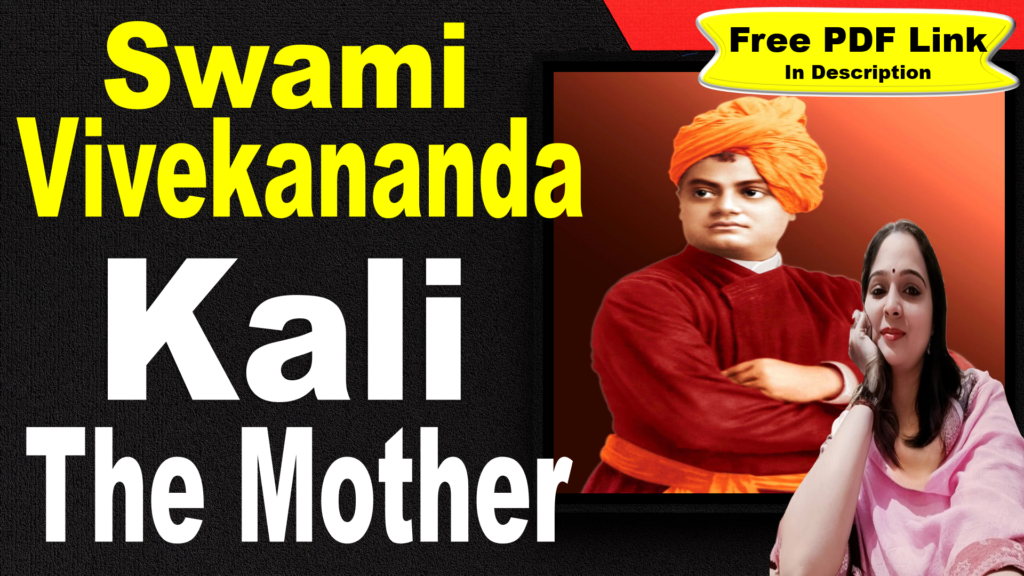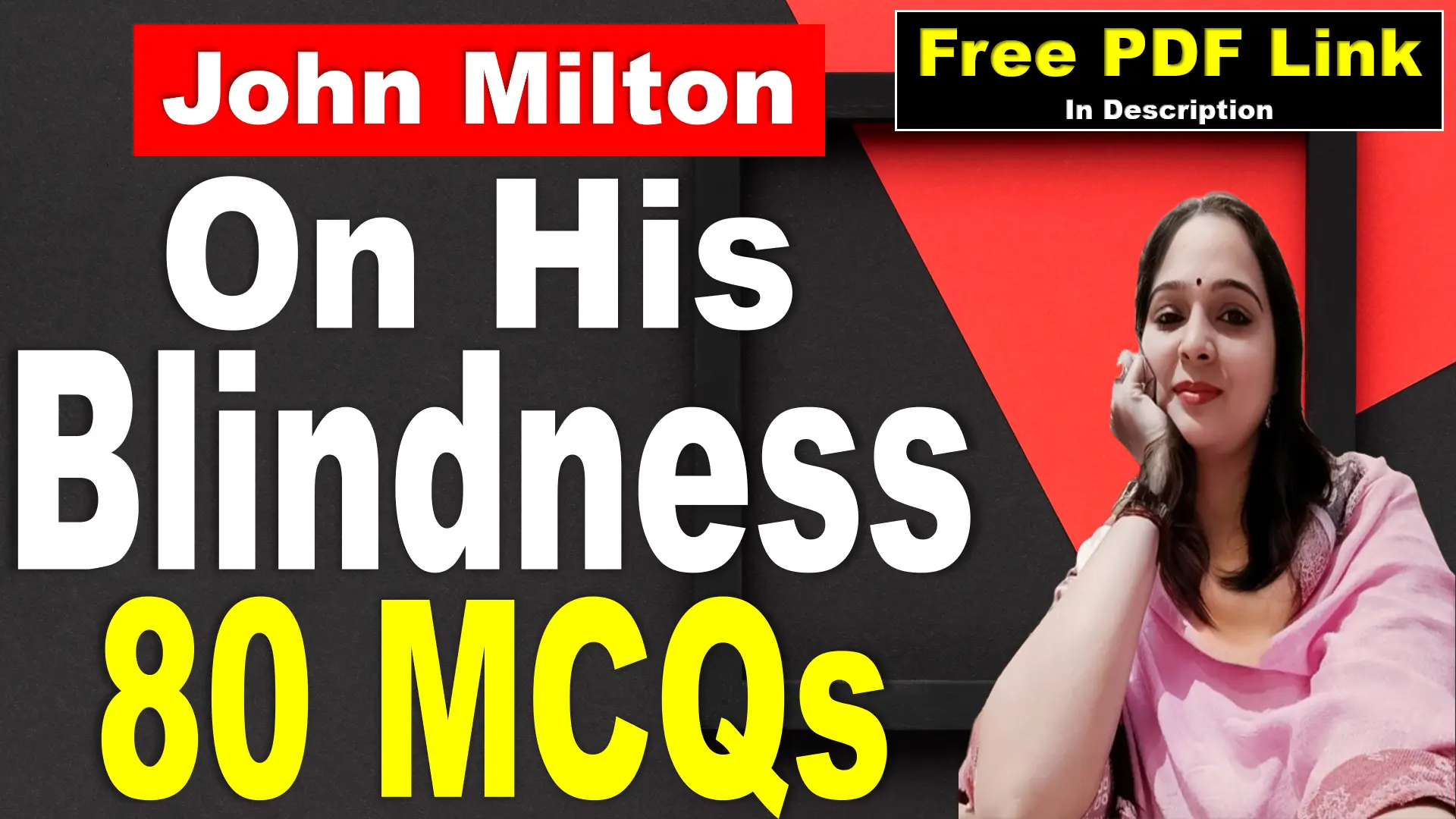
Essay Type Questions
Write the critical appreciation of the poem “Kali the Mother” by Swami Vivekananda.
Introduction:
“Kali the Mother” is a profound and spiritually charged poem written by Swami Vivekananda. Known for his contributions to Vedantic philosophy, Vivekananda penned this poem during a period of deep spiritual reflection in Kashmir. In this poem, he invokes the Hindu goddess Kali, who symbolizes destruction and transformation. The poem explores Kali’s fearsome aspect, yet portrays her destructive power as essential for renewal and cosmic balance. It presents a bold acceptance of suffering and death, showing that only by embracing these forces can one achieve spiritual liberation.
Central Idea:
The central idea of the poem revolves around the destructive power of Kali and its role in the eternal cycle of life, death, and rebirth. Vivekananda reflects on how destruction, rather than being feared, should be embraced as a force of spiritual transformation. The poem suggests that Kali’s terrifying aspects—chaos, death, and misery—are essential parts of the cosmic order and lead to ultimate spiritual liberation. It calls for fearlessness in the face of suffering and death, which are inevitable and necessary in the universe.
Structure & Rhyme Scheme:
“Kali the Mother” is written in free verse, without a fixed rhyme scheme or meter. This lack of formal structure mirrors the chaotic and unpredictable nature of the goddess Kali herself. The free-flowing form allows Vivekananda to express the intensity and fluidity of destruction without being confined by rigid poetic rules.
Theme:
Destruction as a Path to Renewal: The poem highlights the idea that destruction is a necessary force in the cosmic cycle, clearing the way for creation and renewal. Kali’s role is to end the old so that the new may arise.
Embracing Death and Suffering: The poem suggests that spiritual growth requires accepting death and suffering as inevitable aspects of life. To love misery and welcome death is to understand the deeper truth of existence.
The Power of Kali: Kali is depicted as a powerful, all-encompassing force that transcends time, life, and death. Her presence represents the unstoppable nature of change and transformation in the universe.
Style:
Swami Vivekananda’s style in this poem is highly symbolic, vivid, and intense. He uses stark and powerful images to evoke the chaotic and destructive energy of Kali. The language is often direct and confrontational, as the speaker calls upon Kali to come in all her terrifying glory. There is a sense of reverence mixed with fearlessness in the way the speaker addresses the goddess. The use of free verse further enhances the fluid, unpredictable nature of the poem, allowing the ideas of destruction and chaos to flow freely.
Poetic Devices:
Imagery: The poem is filled with striking visual and sensory imagery, such as “mountain-waves”, “whirling wind”, and “pitchy sky”, creating a vivid picture of destruction.
Personification: Nature is personified to represent Kali’s power, with elements like wind and sea acting as destructive forces under her command.
Metaphor: Kali is compared to time and death, emphasizing her role as the ultimate destroyer in the universe.
Oxymoron: The juxtaposition of opposing ideas, such as “dancing mad with joy” and “who dares misery love”, highlights the paradoxical nature of destruction and joy in Kali’s dance.
Critical Commentary:
Critics and scholars of Swami Vivekananda’s works often interpret “Kali the Mother” as a reflection of his profound relationship with the goddess Kali. Some view the poem as his personal exploration of the divine, where he confronts the darker aspects of spirituality—suffering, death, and chaos. Others highlight how the poem aligns with his Vedantic teachings, where destruction is seen not as evil, but as part of the larger spiritual evolution of the soul. Kali, in this context, becomes a symbol of the divine power that transcends human limitations, bringing both destruction and liberation.
Message:
The poem conveys a powerful message of spiritual acceptance. It encourages the reader to embrace suffering, death, and chaos as natural and necessary parts of life. Vivekananda suggests that destruction is essential for growth, and true liberation comes from facing life’s darkest aspects without fear. The poem challenges the common human desire to avoid suffering and death, instead presenting them as integral to the cosmic balance and the path to spiritual enlightenment.
Conclusion:
“Kali the Mother” is a spiritually intense poem that captures the essence of Swami Vivekananda’s vision of the divine. Through vivid imagery and a free-flowing structure, Vivekananda brings to life the powerful, terrifying presence of Kali, the goddess of destruction. The poem not only reflects his deep spiritual insights but also conveys a message of fearlessness in the face of suffering and death. In embracing Kali, Vivekananda suggests that we find liberation and renewal through destruction, accepting the inevitable cycles of life and death as part of the divine order. This critical appreciation highlights the depth of Vivekananda’s spirituality and his bold approach to the concepts of death, destruction, and transformation.
Long note on themes used in the poem ‘Kali the Mother’ by Swami Vivekananda.
Destruction as a Path to Renewal:
The poem highlights the idea that destruction is not an end but a necessary precursor to creation and renewal. Kali, as the goddess of destruction, is a force that clears the old to make way for the new, symbolizing the cosmic cycle of life, death, and rebirth.
Embracing Death and Suffering:
A central theme is the acceptance of death and suffering as integral parts of life. The speaker invites Kali and her destructive power, showing that one must embrace misery, death, and chaos without fear to achieve spiritual liberation. Suffering is seen as a transformative force leading to higher understanding.
The Power of Kali:
Kali is depicted as the ultimate force of destruction, chaos, and time itself. Her terrifying presence embodies the inevitable decay and end of all things. She represents both the fearsome aspects of life and the divine power that controls the balance between creation and destruction.
Cosmic Chaos and Order:
The poem suggests that chaos and destruction are essential components of the cosmic order. Natural elements like storms, wind, and the sea participate in Kali’s destructive dance, indicating that the entire universe operates within a cycle of chaos that leads to eventual renewal.
Spiritual Courage and Liberation:
Another key theme is the spiritual courage required to confront fear, suffering, and death. The poem suggests that only those who can “hug the form of Death” and dance in destruction’s dance can truly experience Kali’s divine presence and attain liberation from worldly fears.





